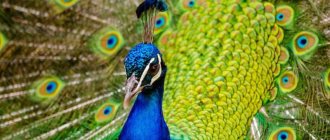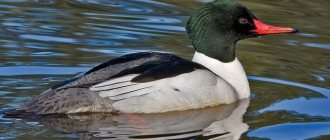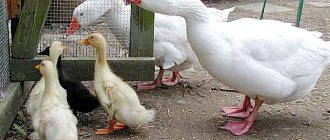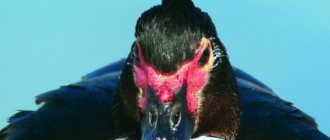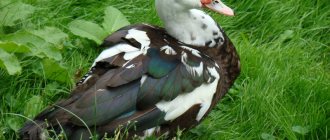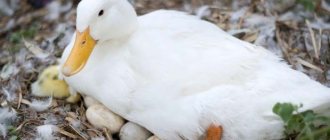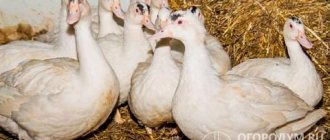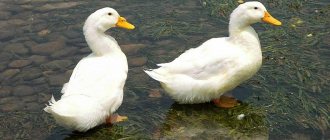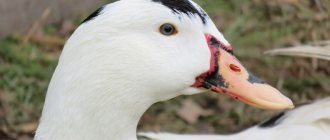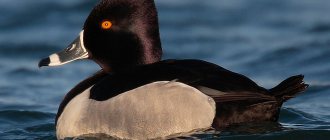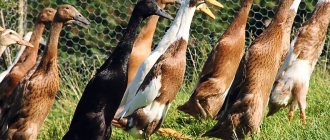The male duck, the drake, belongs to the same species as the female, but it is not difficult to distinguish them visually. This can be done by both a professional (hunter, farmer or duck breeder) and a simple layman. To determine who is a female and who is a male, just look at the color of the bird's plumage.
The male duck, the drake, belongs to the same species as the female.
Why is it important to find out your gender in advance?
Poultry farmers who have embarked on the exciting journey of raising ducks know that timely sexing is key to the success of the future flock and gives farmers the opportunity to increase the productivity of their flock.
Determining the sex of a chicken provides the following food for thought:
- the optimal ratio of females to males in the herd should be 4: 1 - if the goal is to increase the number of eggs, you should get closer to these values;
- When breeding meat ducks, the number of males should be increased as they produce more meat - the female to male ratio can be adjusted early on;
- males have a good immune system, and they get sick less often - again a reason to think about increasing the offspring of male ducks;
- females are soft, calm, obedient and rarely fly - if a large number of ducks are found, an appropriate cage should be built.
Knowing your gender allows you to develop a detailed feeding plan in advance and purchase the necessary food.
Why know gender?
For professional breeding of any birds, including waterfowl, it is imperative to understand the difference between female and male birds. This is necessary to calculate the future offspring and the correct formation of the herd. Drakes are always stronger and more resilient than ducks, and their desire to fly is difficult to hinder. The female part of birds, on the contrary, leads a quiet lifestyle, spending most of their time on the ground.
Female duck with offspring
In order for breeding to be as efficient as possible, and for birds to regularly lay eggs, it is recommended to keep 25% of males from the entire flock. If the farmer’s goal is to produce duck meat, it is necessary to distinguish between the sexes, since males are always larger, and accordingly, they have more mass. But on the other hand, for the owner to make a profit from this, the birds must actively reproduce. Therefore, for the best result, the number of “girls” should exceed the number of “boys” by approximately 4 times.
Basic methods
There are several ways to distinguish a duck from a drake.
- Sexual characteristics. Using this technique, you can determine the sex of a day-old bird as accurately as possible. To separate the girls from the boys, place the birds on a flat surface with their backs down. Then gently pull the skin in the cloaca area up towards the abdomen. Females have two small balls in this place, and in chicks the organs are developed or underdeveloped.
- Ultrasound. Modern equipment is used to determine gender. Special devices that emit a specific frequency can help distinguish the sex of birds. When using this technique, the device is turned on at a certain frequency and the behavior of the birds is closely monitored. Same-sex birds gathered around the device are collected and placed in a separate cage.
- Voice. Another way to help differentiate between genders is to use specific sounds. They are different for both genders. Males often hiss and whistle, while females are distinguished by loud sounds. The usual sound (quacking) is made by females. This is the simplest method, but it cannot boast of reliability. Bird calls can vary depending on the breed.
Conditions of detention
Bashkir ducks live in cages and pens and quickly adapt to new conditions. Under comfortable conditions, the rate of egg production and meat productivity increases. A prerequisite is to maintain a constant temperature in the duck house, especially in winter. Poultry do not tolerate drafts and need constant access to water.
Ducks do not need artificial or natural ponds to swim regularly. Water is necessary for wetting and cleaning feathers and drinking. Birds' wings do not get wet after bathing.
Feeding the Bashkir duck
Poultry are unpretentious eaters. They have a shortened stomach and accelerated metabolism, so they should have three meals a day. 2-3 kg of feed is needed per 1 kg of growth. By 2-3 months, birds weigh 2.5-3 kg and are ready for slaughter.
The basis of the diet is a grain mixture, silage, hay, dried grass, chopped vegetables, boiled root vegetables. To avoid vitamin deficiency, include feed and mineral supplements in your menu. The presence of crushed chalk, gravel or sand is required.
Be sure to control birds' access to water. A duck drinks up to 2 liters per day. The water should be fresh, update the drinking bowls regularly. If mold or algae appears, clean and disinfect it.
The bird needs a regime:
- before lunch – wet mash of cereals and mixed feed;
- after lunch - dry food, silage and hay.
Give the ducks a fresh portion of food each time. Stagnant and sour feed causes digestive problems, dysbacteriosis, intestinal infections, and can lead to the death of poultry.
Poultry house arrangement
When arranging a poultry house, avoid dampness and drafts. Install the structure at a height of 0.3 m above the ground. This way the floor in the poultry house will be warmer, and rodents and harmful insects will not get to the poultry.
Basic requirements for the housing of Bashkir ducks:
- Place the nests away from the entrance, since the bird is very afraid of drafts and gets sick more often.
- To make nests, use wooden crates and boxes; avoid plastic structures.
- Place feeders in the poultry yard, otherwise sloppy ducks will spill food indoors. In this case, the wet mash becomes moldy and can cause illness in the poultry house inhabitants.
- To prevent ducks from spilling water, firmly fix the drinking bowls. Make sure each bird has its own drinking container.
- For high fertility, adjust the lighting. For a room of 10 sq. m required power – 50 W. For high egg production, the daylight hours should be 14 hours.
- Ensure high-quality ventilation of the room, otherwise bacteria multiply in stale air and the fertility of ducks decreases.
Features of care
Clean the house daily. In a dirty room, birds get sick more often. Each time, give the ducks a fresh portion of food and update the drinking bowls. Cleanliness is the key to the health and fertility of poultry.
Set up a walking and feeding aviary near the poultry house. Sow it with clover and alfalfa, and arrange an artificial pond nearby with fresh grass on the shore. Graze your birds daily to help them gain weight faster.
In winter, lay a bedding of straw, sawdust or peat on the floor to prevent the birds from freezing. Keep the bedding clean and dry, otherwise the Bashkir duck becomes lethargic, eats poorly, and gets sick more often.
Appearance
It is worth noting that for bird breeding it is very important to distinguish between ducks and ducklings. This knowledge is necessary for the correct distribution of the flock and determining the number of birds of both sexes in the flock. This indicator will affect egg production and future productivity.
Differences between men and women can be significant or minimal. Males have the following external features:
- males are larger than females, have a large and massive beak;
- The shape of the forehead is triangular;
- the plumage is bright, bright;
- a small amount of feathering around the chin;
- the neck is decorated with a miniature tuft of feathers.
Wild ducks have the following external characteristics:
- The plumage is monochromatic and monochrome, in dull and muted shades;
- The birds have no voluminous curls on the tail;
- The shape of the forehead is trapezoidal.
According to experts, in rare cases, ducks can be larger than ducklings. It depends on the feed and the specific conditions of detention. For this reason, it is not recommended to determine gender solely on this basis. This is not a reliable option.
Breeds
| Indo duck breeds | Description |
White | A very elegant bird. The plumage is bright white. Eyes blue or gray. The beak is pink. |
White with a pattern | The plumage is predominantly white. Dark spots are located randomly. The eyes are brown, the beak is usually dark-colored. |
Black and white | As the name implies, the tone of the pen is black with a green or lilac tint. The head with neck, chest, and mirrors on the wings are decorated with a pattern of white feathers. The eyes can be gray or bluish, but are usually brown. The beak is black. |
Black | This breed has a completely black cover feather with an emerald or purple tint, and the beak is the same color. The pubescence is gray, the eyes are brown. |
| Blue | The feather is gray with a darker border around the edge, the beak is black. The eyes are brown. |
| wild | The feather is black, cast in a wide variety of shades, even purple. The outer feathers on the wing are white. Black beak and brown eyes. |
| Wild blue | The feather is gray with a dark edging. The chest is decorated with a white pattern. The bird's eyes and beak are the same tone as the previous breed. |
Brown wild is also named by suit | The feather is predominantly light brown in color with a greenish or lilac tint. The duck's eyes are brown. The beak is red. |
Brown-white | The chocolate-brown feather has a green tint. The flight feathers, as well as the pattern on the neck, are white. Like the previous breed, the beak is scarlet and the eyes are brown. |
All these breeds do not have significant differences in bird size, egg production and meat quality. Males weigh on average 4-5 kg, females - 2 or 2.5 kg. With good care and rational nutrition, the weight can be significantly higher - up to 7 or 8 kg in males and 3.5-4 kg in females.
Character
Another parameter to consider when classifying waterfowl by sex is their nature. As experienced ornithologists note, males almost always stay away from females. When moving, they miss the leading ducks.
In terms of activity, male ducks are more active than females. Males are noisy, active and aggressive. In nature, males often fight among themselves. These are general character traits needed to demonstrate strength and dominance. Men in herds demonstrate their dominance in the herd in order to attract the attention of women and secure their position. The characteristics of the leaders are shown by the duck man in relation to all other men.
Ducks are more peaceful and friendly. Conflicts between women are quite rare. In addition to being peaceful, ducks are less active and much less likely to be killed.
In some herds there may be an imbalance in gender distribution, so females may act more like males, showing strength and activity. The normal ratio is one female to 4 males.
Sex determination using the Japanese method
Thanks to this method, you can calculate gender with 98% to 100% accuracy and even one-day babies can be sorted by gender. When using this method, great care should be taken, since the manipulation of sex determination can be dangerous for the young. All you need is time and a trained eye to get an accurate reading!
External quantity
What manipulations should be followed:
- Gently place the duckling in your left hand with the tummy facing upward and massage for a few seconds.
- Use your thumb and the finger pointing to your right hand to gently open the cloak and turn the anal wall to the genital side.
- If spiral-shaped penises with dimensions of 1.5 to 2 mm appear in the folds of the mucous membrane, it can be 100% considered to recognize that the person is human. Only flat, spherical sparklings are visible in females.
WENTSEXING method indicate bird sex
Regulation of egg laying
As soon as a mature duck begins to lay eggs, it is necessary to ensure constant control over the intensity of egg laying. If the increase in egg production is insufficient when compared with standard indicators, it is recommended to sharply increase the duration of the photoperiod. If it is noticed that egg production has become extremely fast, which can lead to weakening of the duck, it is necessary to very slowly lengthen the duration of illumination.
Typically, the duck house uses not very powerful light bulbs of 75 W, the number of which is calculated based on the need to provide approximately 5 W of illumination per square meter. Such an artificial extension of daylight hours will be necessary until natural illumination reaches 15–16 hours.
How to distinguish a musky duck from a drake?
Poily pajnamic duck or turkey duck is called spruce. Its appearance differs from its counterpart: it has a wide chest, powerful wings and a limb.
The name of the race comes from the word musk: it is believed that the oldest representatives of this species emit fat with a specific odor through the pores of the skin of the body.
Duck mask: woman and duck
This race is quite popular in breeding due to the following factors:
- Turkey meat has a very tender, pleasant taste and is dietary;
- Eggs are also used for cooking;
- Birds of this breed do not need eye water near the outer surface;
- Birds are kept indoors, which significantly reduces the risk of losing the flock due to sudden escape.
There are wild species, as well as domesticated ones.
Turkey rooster is a large specimen with its plumage
The main differences between musk duck drakes and females
The main differences in appearance between male and female turkeys are the same as in the case of the entire duck family:
- Size: the male is always larger than the female, with a maximum weight difference of 0.5 to 1 kg, and the male body is wider, with a well-developed abdomen;
- Feather Color: Women look simpler and more modest compared to men. All women's efforts are aimed at care and protection. Bright plumage will only attract unwanted guests and endanger the lives of the chicks. While hens must be conspicuous and attract attention to females to ensure continuity of offspring;
- Neck: Women, as it should be for women, have a neck that is more prominent and graceful, while men have a neck that is stronger and wider.
External differences in turkeys begin to form only after 3 months.
From 3 months, the listed external signs appear and only after a few seconds of curved inspection to determine the sex of the bird.
Indo-duck laying eggs and incubating chicks
When do Indian ducks start laying eggs? As soon as it gets warm, in March-April. Female Indian ducks, ready to lay eggs, are very nervous. Therefore, during this period you should not make loud noise near the poultry house.
A good idea is to build a house for each duck in the house out of thin plywood with a hole so that she can climb in and build a nest.
Female Indian ducks are very curious. There are times when they occupy someone else's nest and begin to lay eggs there. Or they sit on other people’s eggs in order to hatch them, but forget about their own.
In the house, the female will not have much visibility and will only take care of her offspring. If it is not possible to build houses, plastic lattice vegetable boxes with a high side are suitable for nests.
It is imperative to place a small basin of water next to the laying female Indian duck. It will have to be changed frequently. The duck will drink this water and splash it on itself, wetting its feathers. This is how she gets rid of the parasites that appear during the laying period on dry feathers.
Egg collection must be suspended if you want the turkey to begin hatching chicks. Gradually, the female can lay up to 20 eggs. We take 10 pieces, don’t touch the rest - then she starts hatching. Indoor chickens hatch for a long time - more than a month.
Indian duck eggs in a nest, photo
Important - the quality of meat, eggs and fertility of turkey ducks drops sharply from closely related contacts. Therefore, drakes need to be updated regularly, preferably every season.
If you strive to eat healthy and tasty and love to breed poultry, indo-ducks will be the best option.
Indo-duck meat is now in high demand in prestigious restaurants. So there will be no problems with selling surplus meat if the number of turkey ducks on the farm is large. Watch a video about Indian ducks.
This is interesting!
You don't know how to determine the gender of a budgerigar? Then this is the place for you! It turns out that many people still have no idea how to distinguish a male from a female. Not every professional can do this until 3-4 months of age. But it is still possible!
About the article
Folk way
It also tests fairly simple ways to distinguish ducks from chicks, which were used by our ancestors and modern farmers.
- Men have a large larynx. To test this, shuffle the chicken's breasts. Move the head to the side, raising the beak so that the neck is just. Place your left thumb on the top circle and use your index finger to find and enter the bridge triangle. It should contain a tube, a hard wallet combined with a bridge, scapula and collarbone. Only men have this feature.
- They say that male Ducklings get into fights and conflicts. And it doesn't matter what the reason is. The reason may also be the desire to dominate near Karmnik, and shows signs of gender interest at the age of 1 month and older. If you see them in a herd, you can be sure they are male.
Behavior of drakes during mating season
During the mating season, ducks and drakes of ordinary breeds behave equally actively. The ratio of ducks to drakes is 4 to 1, especially in the Muscovy breed. Ducks mature sexually earlier, so the male should be 1-1.5 months older. For breeding purposes, it is recommended to use drakes for 3 breeding cycles, after which the birds are no longer so good for procreation.
Under no circumstances should you force the molting process in males! The drake may lose potency and will not trample ducks and fertilize eggs. As a result, it will not leave offspring - and how much effort of the breeders will be wasted! To avoid such an unpleasant situation after egg laying, it is better to transplant it to recently moulted ducks.
Often, male musk ducks are used to breed so-called mulards. To do this, it is necessary that the female and male match each other in color. That is, if a musky male is gray, then the female of the usual breed selected for him should also be gray. But it is worth considering that musk drakes are very indifferent to fulfilling their “marital duty,” especially with females of other breeds, so most of the eggs may be unfertilized. For one such drake there are no more than 4 ducks.
How to determine the sex of a duckling
Basic proven and scientific methods for distinguishing male from male Duck are of great help to the novice and inexperienced breeder in breeding a high quality and efficient flock of birds. They include the following identification methods:
- by external signs;
- the character of the bird;
- Gender characteristics;
- Vocal feature of the kacznia family;
- Using ultrasound.
Buying poultry at the market can cause problems for the buyer. And finally, the main goal of the breeder is to sell all the chicks, so as not to keep the remains of one or the other sex. In such situations, do not indicate the gender of the ducklings, use a trick - ask for a self-propelled duck in a box and apply the folk method - turn them with their feet on their heads, holding their feet. Boys rebel and twist, girls hang without resistance.
How to recognize the sex of chicks that are a day or a week old is described below.
- The first method is in itself. This is a very simple and common method. Take the duckling's feet and observe its behavior by turning the bird's head upside down. Anxiety and nervousness indicate that it is human. They begin to turn and turn their heads, while the woman hangs still and is quiet.
- There is another variation on the theme of behavior. Boys Many Ras have a warrior character and often get into fights among themselves. From an early age, ducklings break feathers and are shy of each other.
- The body structure and some anatomical features are clearly symbolized in the bird's specifications. Special markings can be found near Krtani. Males have spherical masses in this area of the upper body. They are easy to feel.
Palpation of the larynx
There is another way to determine the sex of birds. There are anatomical differences in the larynx between vigorous gender penchels. Husband duck extend the larynx. This is a ball shape. Women do not have this function. The spherical extension can be detected by palpant:
- The duckling rises. Place it on your stomach in the palm of your hand;
- on the one hand, stretching the neck;
- The second hand perceives the expansion in the upper chest;
- The treatment is painless and safe.
There are traditional methods of determining sex, but they are ineffective. Some courtyards suggest leaving the individual's head down. If he hunts and raises his head, it is a man. It is believed that Kura women have a marriage, a warrior. Women, on the other hand, they will hang upside down.
This folk method is not very true. It is also dangerous for ducklings. It's not a good idea to keep them upside down for long periods of time. It is better to run to the larynx palpation and check the fur coats. Experts say that these methods are very effective. The accuracy is 98%.
Care
These birds do not like the heat too much, so if ducks are kept in the warm season, then portable bird houses should be used.
During the cold period, it is necessary to create warm conditions in the poultry house, since initially this type of duck lived in a warm climate, which is why fat did not accumulate under the skin, and to this day the ducks are freezing.
In winter, a solid, strong, permanent poultry house is needed, which will allow the birds to shelter from the sudden onset of cold. The inside should be light and dry, and other animals and birds should not be able to get inside the house. It should belong only to these birds.
Birds need to be walked. Not in the sense that applies to dogs and sometimes cats, but still necessary. You need a medium-sized courtyard in which the Indian ducks will spend enough time. The yard must be fenced with a fence or mesh.
Twitch in pigeons: symptoms and treatment
If it is not possible to organize a proper poultry house, then Muscovy ducks can be kept in cages.
If possible, the poultry house should be divided into parts. One of them should be covered with a mesh with two-millimeter rods at a height of 25 centimeters. In addition, it is necessary to lay good permanent bedding.
The house should contain items that will provide comfort to the birds. Such items include:
- Feeders. Wooden or metal. Dry food goes well with wood, and wet food goes well with metal.
- Drinking bowls. Must have a large volume and free access to them at any time. Indian ducks need a lot of water.
- Nests. Nests must be arranged on the floor, lined with fresh straw. The straw must be changed in a timely manner. You can make a nest in the form of a house with an entrance at a level of 10 centimeters above the floor.
The temperature inside the poultry house should be about 18–20 degrees Celsius, however, it should not fall below 15, as the ducks will begin to freeze, which can lead to illness.
